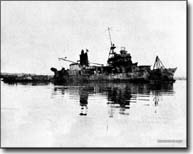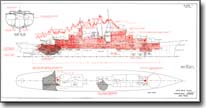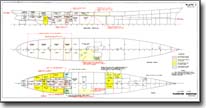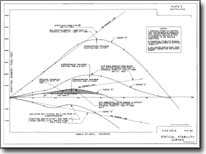



If you can see this text here you should update to a newer web browser
Normal | Highlight & Comment Highlighted Text will be in Yellow, but there are none yet
|
RESTRICTED
1. At 1733, 12 October 1942, a torpedo detonated about 5 feet below the waterline at frame 126, starboard (Plate 1, 2). The hull below the waterline was ruptured for a length of 45 feet. Transversely, the break extended from 5 feet to starboard of the keel up to the main deck and across the main deck almost to the port side (Photo 1). Fuel oil, diesel oil and gasoline tanks in way of the explosion were demolished, and the platform and second decks were ruptured. On the 2nd deck, bulkheads 119 and 131 were torn and the watertight door in bulkhead 107 was distorted and could not be closed. Oil and gasoline spread throughout the flooded 2nd deck compartments between bulkheads 99 and 141. This flooding represented about a 25% loss of waterplane area. A few seconds later a second explosion of considerable intensity occurred in the same area, probably the result of ignition of gasoline vapor. Fire, fed by gasoline and fuel oil, spread rapidly throughout the 2nd deck and through the after superstructure. Within 12 minutes, ready service ammunition for 6" mount 4 began to explode. 2. The torpedo detonation produced an initial list to port, but immediately thereafter ERIE began listing gradually to starboard and settling by the stern. Course across wind was maintained for a few minutes to prevent spread of the fire forward to the 6" ready service rooms and aft to the depth charge stowage. Increasing list and trim made sinking appear imminent, so course was changed to head for the beach about 4 miles away. List had increased to 15° and the main deck was underwater aft of frame 104 starboard when ERIE grounded at 1823. After grounding ERIE assumed a slight port list following the contour of the bottom. 3. After grounding, burning oil and gasoline spread forward and encircled ERIE, except for a small portion of the bow. Almost the entire superstructure was afire within 2 minutes. ERIE was abandoned at 1826, 3 minutes after
|
|
RESTRICTED
grounding. The uncontrolled fires had nearly burned out by 14 November when a party boarded ERIE and extinguished all fires above the 2nd deck. Fires below the 2nd deck were not extingulshed until the following day. While ERIE was beached the port shaft alley flooded as the result of grounding damage. 4. Salvage operations under the direction of Merritt, Chapman and Scott were begun on 19 November. The topsides were stripped, debris was removed from the 2nd deck, stores were removed from the platform decKs and several tanks were emptied. The anchors and chains were removed making the total weight removed about 375 tons. About 20 tons of oil remained in A-4F and A-418F. The stern aft of the damaged area remained buoyant during the entire time ERIE was beached. 5. On 28 November, ERIE was hauled off the beach and towed to Willemstad Harbor. When refloated, drafts were 8 1/2' forward and 24' aft and ERIE had a 8 1/2° port list. The stern drooped an estimated 24". Between 28 November and 5 December operations apparently were limited to removing accumulations of rainwater and seepage. At a conference on 3 December it was decided to place ERIE in a local drydock for sufficient temporary structural repairs to permit safe tow to a shipyard. It was decided to remove the list and reduce draft aft to 20' to prepare ERIE for drydocking. This was to be accomplished by removing additional scrap and debris, removing the fuel remaining in A-418F and A-4f, flooding forward compartments and placing counterweights on deck. On 4 December the anchors and chains were replaced and pumping of the two tanks was completed at 1930. This left ERIE with about a 5° port list. 6. At 0300, 5 December, 7 1/2 hours after pumping was completed, guards aboard observed that ERIE had righted and was beginning to list to starboard. Motion was slow and jerky and eventually stopped at about 10° when the hull rested against a fuel oil barge secured on the starboard side. D-1W, 43 tons capacity, which previously had been leaking at the rate of 200 gallons a day, was found to be full. Water was found to be running in on the 2nd deck from B-201-ILE, apparently through drains, and into C-201L. Flooding in C-201L extended at least to the centerline trunk since water was reported running down this hatch into the engine room. A slight gain was made on this flooding using a portable pump. A-418F and A-4F were completely filled to remove the list. About 12 minutes after this operation was completed, ERIE started to come upright, then passed the vertical and with increasing acceleration capsized to port.
|
|
RESTRICTED
Analysis of Stability, (Plates 2, 3) 7. The best estimate of ERIE's displacement before damage is 2730 tons, giving a corresponding draft of 14' 2". This corresponds closely with Condition VI of the inclining experiment data. Curve A of plate 3 is the curve of statical stability for this condition. GM, uncorrected for free surface, was about 3.0'. Although the distribution of liquids is uncertain, free surface correction could not have been greater than 3" and is omitted. ERIE was in a condition which offered the greatest resistance to underwater damage and also provided satisfactory stability characteristics. 8. As determined from the inclining experiment, the metacentric radius (BM) before damage was about 11.1'. Flooding resulting from the explosion reduced the waterplane area by about 25%. A quick estimate of GM after damage which could and should have been made on the spot is as follows; Assuming BM varies linearly with length of the intact waterplane, a 25% reduction in the length of the intact waterplane is accompanied by a 2.8' reduction in BM and approximately the same loss of GM. This hasty estimate indicates that before beaching GM was reduced to 0.2' a precarious condition of initial stability. More precise calculations made later indicated that GM, uncorrected for free surface in the forward tanks, actually was about zero. Curve B of plate 3 is the statical stability curve of ERIE immediately after damage. In this condition the maximum righting moment is 675 tons-feet, 14% of that before damage. The range of stability decreased from 70° to 43°. The total dynamic stability required to cause capsizing was reduced from 3567 to 283 foot-tons, a reduction of 92%. Flooding of the starboard shaft alley, D-403E, which was the only known unsymmetrical flooding, produced a heeling moment of 330 tons-feet which Curve B indicates would produce a list of 15°, the list actually reported by ERIE. The crosshatched area on Curve B is the residual dynamic stability with 15° list and shows that the dynamic stability in the upright condition was reduced about 2/3 when the 15° list was assumed. These detailed calculations reiterate the critical stability condition of ERIE when beached. 9. About 375 tons of weight were removed during salvage operations while ERIE was aground. Although all possible topside weights were removed, much of the removed weight, including 200 tons of liquid, was low. Therefore, the lowering of the center of gravity and increase in GM was comparatively small for the amount of weight involved.
|
|
RESTRICTED The center of gravity was lowered only 0.4' and GM was increased only to 0.7'. Curve C of plate 3 is the stability curve for this condition. At small angles, below about 15°, the effect of weight removal is not appreciable. The greatest effect was to increase the maximum righting moment to about 1900 tons-feet and to increase the range of stability nearly to the intact value. The total dynamic stability required for capsizing was increased to 1124 tons-feet, about 32% of the intact value. Although stability when ERIE was refloated was considerably better than it had been before beaching, ERIE was still in a critical condition. The 8 1/2° port list when ERIE was refloated could have been caused by unsymmetrical distribution of remaining weights. The flooding of the port shaft alley and the 20 tons remaining in A-4F and A-418F would have been sufficient to cause this list had ERIE been otherwise balanced. 10. The effects of the activities on 4 December, i.e., replacing the anchors and chain and removing 20 tons of liquid from A-4F and A-418F, was to reduce GM from 0.7' to 0.5', to reduce the port heeling moment by about 200 tons feet, thereby reducing the port list from 8 1/2° to 5°. Neither the removal of liquid nor adding of topside weight was advisable, even though initial stability remained positive after the operations. They indicate lack of appreciation of ERIE's poor stability condition. 11. D-1W apparently flooded slowly, since the list did not change abruptly. This flooding produced a 667-tons feet heeling moment, which from curve C would cause 18° total list. Since ERIE had a 5° port list, a 13° starboard list could be expected. Actually, the barge alongside prevented listing beyond 10°. Flooding of D-1W produced an after trimming moment of 5200 tons-feet which would cause a 34" change of trim, reasonably close to the 3' estimated by the Commanding Officer. Flooding of D-1W also caused a slight increase in GM. 12. The free surface effect, incident to the flooding on the 2nd deck, reduced GM by 1.6' to -0.9'. ERIE probably would have capsized to starboard had not the barge prevented. Counterflooding of A-4F and A-418F provided an ever increasing port moment. Curve D of Plate 3 is for D-1W flooded, free surface to the centerline of C-201L, and A-4F and A-418f empty. It is a close approximation of ERIE's stability condition immediately before counterflooding and capsizing. Since neither initial nor dynamic stability was positive, the only immediate action which could have saved ERIE was rapid removal of free surface in C-0-01L and cautious addition
|
|
RESTRICTED
of low ballast either on or to starboard of centerline, thereby taking advantage of the support given by the barge in preventing capsizing to starboard. Although counterflooding A-4F and A-418F increased GM to -0.6', it produced a port heeling moment of 975 tons-feet and made capsizing to port inevitable. The negative stability curve explains the increasing acceleration of the-roll to port. 13. From the available information, it appears that no formal estimates or calculations of ERIE's stability were made at any time during the various phases of the operation. If her stability condition had been known, even approximately, it is probable that more active measures to improve stability would have been undertaken during the period 28 November to 4 December, that low liquids would not have been removed and high weights added on 4 December, and that A-4F and A-418F would not have been flooded so readily. 14. Preparing a vessel with low stability for drydocking is a complex problem and invariably requires a detailed stability analysis and carefully planned operations. It is impossible to establish a definite set of rules to be followed in such cases, since each case is a problem in itself. RALEIGH was successfully drydocked after damage at Pearl Harbor on 7 December 1941, even though GM was only a few inches, a port list existed, and the ship was trimmed 12' by the bow. A complete stability analysis was made and the program for correcting list and trim was worked out in chronological detail before operations began. All preparations for drydocking, including calculations, took about 2 weeks.
|
SOURCE:
Transcribed by RESEARCHER @ LARGE. Formatting & Comments Copyright R@L.
Erie Home |
Ships Home | Repairs in Forward Areas Home | Researcher@Large Home